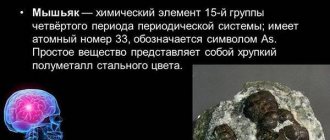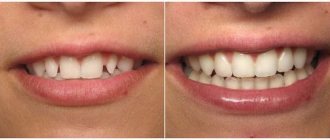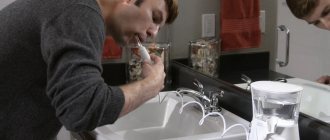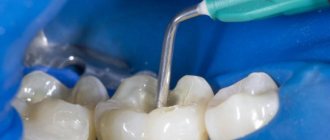Dentists are one of the few doctors whose visits patients prefer to postpone. Therefore, treatment of advanced caries is not uncommon. If the tooth is severely involved, it is usually necessary to remove the nerve. For this purpose, arsenic-based paste is used. Sometimes even after all the manipulations, the toothache does not go away. We will look into the reasons for this condition in today’s article.
When is it necessary to remove a nerve?
Dentists are trying their best to save the tooth, but, unfortunately, this is not always possible. For example, in case of extensive caries, it is necessary to resort to removing the nerve of the tooth. The nerve (pulp) is responsible for the sensitivity of the unit. Pain and other unpleasant symptoms arise precisely because of inflammation of the pulp. The following conditions are considered the main indications:
- Advanced periodontitis.
- Deep caries affecting the internal tissues of the tooth.
- Acute pulpitis.
Also, this manipulation is indicated in cases where crowns, bridges, veneers and other fixed prostheses are to be installed. First of all, this is done with the intention that the tooth does not get sick under the artificial structure. In this case, the unit is considered dead, but continues to perform its functional duties.
Who is indicated and who is contraindicated for treatment with arsenic?
When is it appropriate to use arsenic? Typically, such a radical remedy is used when other painkillers are not suitable. In particular, the paste kills the neurovascular bundle in the pulp. Other indications include:
- the impossibility of using alternative options for pain relief due to the patient’s health condition (high blood pressure, taking large doses of alcohol);
- urgent medical care in the absence of other suitable methods of pain relief;
- allergic reaction to similar drugs;
- ineffective pain relief with similar medications due to the patient’s high pain sensitivity;
- baby teeth in children who are afraid of local anesthesia injections.
Arsenic on teeth - a time-tested remedy
The use of the composition is contraindicated:
- children under one and a half years old;
- if the roots are not fully formed or are dissolving;
- when it is difficult to reliably clean the canals using other methods (crooked, overgrown, blocked by tartar);
- if you are allergic to the ingredients of the composition;
- if the channels are not properly cleaned and complete sanitation is not carried out;
- in the presence of artificial holes in the root (separation, perforation);
- with increased eye pressure – a precursor to glaucoma;
- for diseases of the urinary system;
- when carrying a child and during lactation.
During lactation, dental treatment is carried out without arsenic
For children, pregnant and nursing mothers, even a small dose of arsenic entering the gastrointestinal tract can give an unpredictable result.
Along with modern anesthetics, arsenic has not lost its relevance, because sometimes it is simply irreplaceable. In the hands of an experienced dentist, he can treat thousands of patients without pain. The main thing is to be attentive to your body, follow caution and all recommendations so that your health is normal.
- How long can an adult keep arsenic in a tooth?
How does arsenic remove a nerve?
Note that removing pulp using arsenic is an outdated technique. Most often it is practiced in public clinics. First, the patient is sent for an x-ray, then the tooth is processed with a drill and unimpeded access to the nerve of the tooth is created. Next, an arsenic-based paste is placed into the formed bed, and a temporary filling is placed on top. As a rule, it is removed after 1-3 days. After the filling is removed, the canals are cleaned, then a permanent filling is fixed.
Comments
During an examination in kindergarten, the doctor recently diagnosed my daughter with pulpitis of a baby tooth. He spoke with the teachers, mostly in terms of the same terms, and suggested devital amputation of the dental pulp. I wrote out a recommendation to go to the clinic. Then I started reading on the Internet and became even more confused - how does devital differ from vital? How is amputation different from extirpation?
Ekaterina (11/23/2019 at 2:26 pm) Reply to comment
- Dear Ekaterina, the devital method involves first killing the nerve of the tooth using special arsenic pastes, and then extracting it. Vital involves removing the nerve in one visit to the doctor without the use of pastes under a powerful anesthetic. As for amputation, amputation is most often used in children and involves partial removal of the pulp (the coronal part is preserved, but the root part is removed, then the cavity is filled with a special paste that mummifies the remaining part of the pulp to prevent further spread of infection). The nerve is partially removed so that the roots of the tooth can grow, develop, and receive adequate nutrition. During extirpation, both the coronal and root parts of the pulp are removed - this method is used in adults.
Editorial staff of the portal UltraSmile.ru (11/26/2019 at 09:13) Reply to comment
I remember back in my teens I decided to go to the local dentistry in the area, students were just doing an internship there, in general, in order to kill the nerve, they put arsenic on me, but they didn’t make a hermetically sealed filling, in the morning I went to a private clinic, why in public clinics until Is this method still used?
Alexander93 (12/10/2019 at 10:51 am) Reply to comment
My tooth ached, they drilled it out and said that it was necessary to put arsenic, which they did. They told me to come after the weekend. I had such pain in this tooth that I wanted to call an ambulance. On Monday they said that the arsenic had no effect and the nerves were removed live. Why did it happen? Doctor's mistake?
Irina (12/10/2019 at 2:16 pm) Reply to comment
The doctor placed arsenic under the teenager’s filling in order to kill the nerve. But the tooth has been hurting very badly for the second day now. How long will such pain last, and is it dangerous for arsenic to remain under the filling for a long time?
Elvira (12/10/2019 at 7:37 pm) Reply to comment
The doctor put a little arsenic under the filling for the girl, several days have already passed, and the pain is still present, although the doctor himself claimed that the nerve would die within 24 hours. What causes this toothache then, and how can it be relieved?
Olga Rolenko (12/11/2019 at 01:24) Reply to comment
Hello, I have the following question. My son was diagnosed with tooth pulpitis. What to do? Tear out? Or is there a way to cure it painlessly? Waiting for your reply. Thank you.
Zhanna (12/11/2019 at 01:31 pm) Reply to comment
About 5 months ago I went to the dentist to have tooth decay treated. I also often have stomatitis and my gums become inflamed. The doctor put arsenic on one tooth, and everything with that tooth seemed to be fine afterwards. Then she examined another tooth another time and said that I had pulpitis, and suggested putting arsenic first. But then they took a picture and said it was better to remove the nerve. Removed it the same day. But to this day I still have pain when chewing, even though the nerve was removed. Almost half a year has passed. I took a picture twice and everything was clean on it. The doctor examined me and didn’t see anything either. What could this be connected with, how can I find out the reason if two dentists found nothing? Or was it also necessary to first administer arsenic before removing the nerve?
Marina (12/11/2019 at 6:31 pm) Reply to comment
I don’t understand how, with the current level of development of medicine (and dentistry in particular), it is possible to use such a dangerous substance as arsenic. After all, there are alternatives to arsenic paste? Or is there no other way to cure pulpitis? I would like to clarify this issue for the future.
Irina (12/11/2019 at 6:46 pm) Reply to comment
Hello! I have a tooth problem. A long time ago, back in school, I had a filling installed, after 4 years I had repeated caries, the filling fell out. Now it has begun to crumble, the gums are swollen and red. The tooth is a little loose. Is it worth treating it or is it better to remove it immediately?
Larisa Novikova (02/06/2020 at 17:06) Reply to comment
Please tell me, can there be an allergy to such a temporary filling with arsenic? And should the doctor warn me in advance that he will put arsenic in my tooth, which is actually poisonous...
Regina (03/16/2020 at 10:55 am) Reply to comment
At one time, I had more than one tooth treated using arsenic at the initial stage of treatment. I was lucky and never had any complications. But now my son has been given arsenic and he has been complaining of severe pain for three days now. On what day should the pain go away if everything is fine? His follow-up appointment is only in three days, is it worth going earlier?
Angelina (03/16/2020 at 05:49 pm) Reply to comment
Why, when treating a multi-rooted tooth, did the doctor prescribe sessions for me 6-7 days apart, gradually apply the medicine three times, and I constantly felt pain for a long period? Is it normal that after completing treatment, the tooth hurts for another week?
Vyacheslav (04/23/2020 at 07:48) Reply to comment
I have several questions: 1. Is it possible to “kill” the dental nerve simply by applying arsenic? 2. If arsenic does not work and the nerve is still sensitive, can a filling be placed? 3. At what age does a child have a nerve removed before a filling? Is there an age limit?
Jean (04/23/2020 at 08:03) Reply to comment
I would also like to know for what reasons arsenic may not work at all. And then something like this happens: you suffer for 5 days, you go to the doctor, and the nerve is removed alive. And then one asks why he gave the money and suffered
Andrey (04/23/2020 at 08:53) Reply to comment
I had to deal with arsenic treatment, which was not a very pleasant feeling. The first day the tooth ached, I had to numb it. What modern methods of treating pulpitis without arsenic exist? Which ones do you recommend?
Svetlana Yuryevna (04/23/2020 at 10:59 am) Reply to comment
friday after leaving mysnyak tooth aches what are they dividing
Maxim (13.10.2021 at 14:57) Reply to comment
they gave a ticket on October 18, the blom's teeth ache at work
Maxim (10/13/2021 at 02:58 pm) Reply to comment
Write your comment Cancel reply
Does it hurt?
In most cases, the process of pulp necrosis using arsenic is painless. This is due to the pain-relieving components that are present in the arsenic paste. Sometimes patients complain of moderate pain, and this is normal. If you are experiencing severe pain, we recommend that you immediately visit the dentist.
Significant pain is possible if the dentist violated the rules for performing this procedure, for example, put too little arsenic.
Why does an arsenic filling hurt?
When treating a tooth with arsenic, many hope for an immediate cessation of all torment, but the effectiveness of the product increases gradually. Sometimes it takes 2-3 days for complete necrosis of the nerve. As a result, the doctor should receive a completely devitalized pulp, in which there will be no nerve cells that could hurt. After this, he will have the opportunity to calmly remove the waste soft tissue in order to calmly fill the tooth.
For some time after applying arsenic, the tooth continues to hurt. You can make you feel better with the help of Nurofen, Nimesil, Ketorol, Ketanov.
"Nurofen"
"Ketanov" and "Ketorol"
In this condition it is not recommended:
- They put arsenic, but the tooth still hurts
- take large doses of anesthetics;
- warm up the sore side;
- create mechanical stress on the diseased tooth when chewing.
The use of heating pads and warm compresses is not recommended
Do not get carried away with self-medication and pain relief, so as not to miss the phase of transition from normal devitalization to symptoms of pathology. If a tooth hurts for a long time and constantly, this is a dangerous signal, indicating that serious complications have begun, the most severe of which is sepsis.
Prolonged pain indicates the onset of complications
Why does the tooth continue to ache even after such a strong painkiller as arsenic? You cannot endure such pain for a long time, since the consequences of the “feat” are unpredictable. Prolonged discomfort may be a sign of:
- inaccurately selected dosage (in this case, less than the prescribed norm);
- improper treatment of the cavity with arsenic, in particular – a very dense filling;
- advanced forms of the disease, when arsenic is already powerless: with periodontitis, periodontitis, phlegmon, periostitis, abscess;
Tooth abscess is an infectious process that is caused by the accumulation of pus in the inner or outer surface of the alveolar process of the upper jaw or the alveolar part of the lower jaw
- painful reaction to arsenic and other ingredients of the composition (severe allergies and even anaphylactic shock are possible);
- swelling of the gums, fever and other symptoms of periodontitis;
- necrosis of the periosteum and bone tissue;
Necrosis of hard dental tissues
- swelling of the gums in the area of the problematic chewing organ;
- non-compliance with filling technology with arsenic;
- aggressive effect of the drug on dental tissue;
- spread of inflammatory processes from the pulp to the neighboring area.
The exact cause can only be determined through examination; the main thing is not to put off visiting the dentist.
You can't stand the pain, you need to see a doctor urgently
The most common symptoms that should be a cause for concern are presented in the table.
| Symptoms | Description of the causes of the complication | What to do in a specific case |
| Edema | Evidence of a local allergic reaction. Shortness of breath may develop. | Take an anti-allergenic remedy and remove the toothpaste from the tooth in the doctor's office. |
| Redness of the gums | The carelessly applied drug got onto neighboring tissues. | You can wait until the doctor removes the medicine. |
| Black enamel | The enamel layer was exposed to a killing compound. Without bleaching, the stains will be permanently fixed. | The doctor must promptly remove the product and treat the membrane with a special composition that restores the color of the tooth. |
| Weakness, poor health | Drowsiness, dyspeptic disorders, loss of strength, headaches are signs of poisoning that require urgent medical attention. | The dentist must urgently remove the paste and prescribe absorbents that cleanse the organs of toxins. |
The medicine is used strictly according to the norm, but for people with hypersensitivity to its components, this dose is enough to survive all the experiences associated with intoxication. Some patients are afraid to disturb the doctor and bravely wait for the scheduled visit. Such carelessness can sometimes cost not only the health of the tooth, but also the life of the patient.
Further recommendations
When arsenic is present, the following rules must be followed:
- It is not recommended to use painkillers.
- Do not try to heat the tooth, even if it hurts. Such measures can lead to complications.
- For three hours after the temporary filling is installed, try to refrain from eating and drinking.
- Do not rinse your mouth.
If the doctor claims that it is necessary to resort to the removal of the dental nerve, there is no need to panic or refuse this procedure. If this is not done in a timely manner,
the tooth
removed completely. Even after depulpation, the tooth will last for many years.
First aid
To relieve pain, you must take any non-steroidal anti-inflammatory drug. The most popular are Diclofenac, Ibuprofen and Nurofen. They not only have an analgesic effect, but also have an anti-inflammatory and pronounced antipyretic effect. If there are none in your home medicine cabinet, you can drink regular Analgin. Any pills should be taken only after reading the instructions and studying possible contraindications.
It is not recommended to self-medicate and try recipes from traditional healers. Do not apply dry heat to the affected area. If the pain cannot be tolerated and a visit to the dentist is postponed, you should try to extract the arsenic paste yourself. Just follow the steps below:
- First you need to prepare a regular needle, first rinse it with any disinfectant.
- Then you need to brush your teeth with toothpaste and rinse your mouth well.
- If the temporary filling has not yet fallen out on its own at this stage, it can be picked out with a needle. It is important not to touch the soft gum tissue.
- A small gray ball will be easily visible under the filling. You need to carefully pry the paste ball with a needle and try to pull it out.
- After all manipulations, rinsing with a decoction of chamomile or soda is recommended. You can add a small amount of peroxide to the liquid.
- At the final stage, the open tooth cavity should be closed with a cotton swab.
After all the manipulations, it is important to contact the dentist as soon as possible. An open dental canal is an easy way for any infection to enter. Before visiting a doctor, you should try not to eat or drink.











